Check out these 4 watercolor techniques for resisting watercolor. Use them for your next painting and for adding special effects. You can watch Isabella Kung teach this class in our Beeblys WatercolorPainting.com too.
Materials used:
- Arches rough grain watercolor paper (140lb, size 9" x 12")
- Masking or Artist's tape (width 1")
- Wooden board (at least 9" x 12")
- Painting palette for watercolor paints
- Two cups of water
- A towel or rag to dry off the brushes
- Sennelier: oil pastel (white)
- Daiso Japan: oil crayons (set of 24 colors)
- Fineline Artist: masking fluid pen
- Bottle of rubbing alcohol (90%+ alcohol)
- Soft eraser
- Hair dryer (optional)
Winsor & Newton's Professional Watercolor Paints
- Phthalo Turquoise
- Cobalt Turquoise Light
- Indigo
- Winsor Violet (Dioxazine Purple)
- Lemon Yellow
- Rose Doré
- Alizarin Crimson
Brushes
- Mop brush (½" round)
- Rosemary and Co.: Pure squirrel hair mop brush (1" cat's tongue/oval wash)
- Escoda: Angular brush (size 10)
- Escoda: Reserva Kolinsky Tajmyr 1212 brush (size 6, round)
- Stanislaus Imports Inc.: Dagger brush (½")
Step 1:
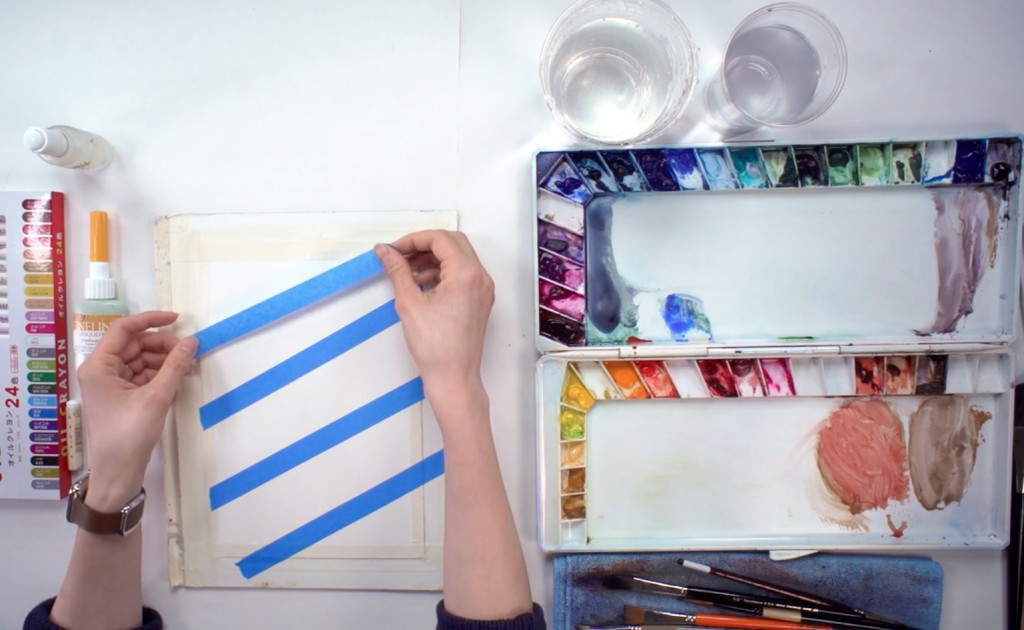 Prep your paper by using masking or Artist's tape to tape all four sides of your paper to the wooden board, leaving about a ½" border of tape that overlaps your paper. Then, tape four strips of tape diagonally across the paper to create a striped pattern.
Prep your paper by using masking or Artist's tape to tape all four sides of your paper to the wooden board, leaving about a ½" border of tape that overlaps your paper. Then, tape four strips of tape diagonally across the paper to create a striped pattern.
Step 2:
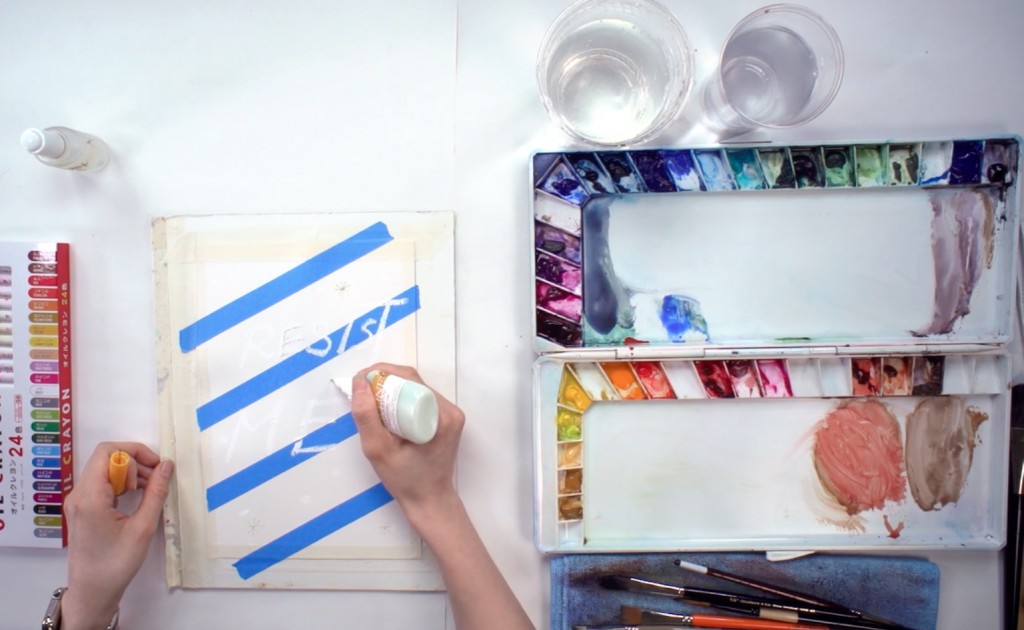 With the Sennelier white oil pastel, write some words over the paper and tape. You can write and/or draw anything you like using oil pastels or crayons; whatever you write or draw will resist any watercolor paint, so try to use lighter colors as they will show up more. For finer details, use the Fineline Artist masking fluid pen.
With the Sennelier white oil pastel, write some words over the paper and tape. You can write and/or draw anything you like using oil pastels or crayons; whatever you write or draw will resist any watercolor paint, so try to use lighter colors as they will show up more. For finer details, use the Fineline Artist masking fluid pen.
Step 3:
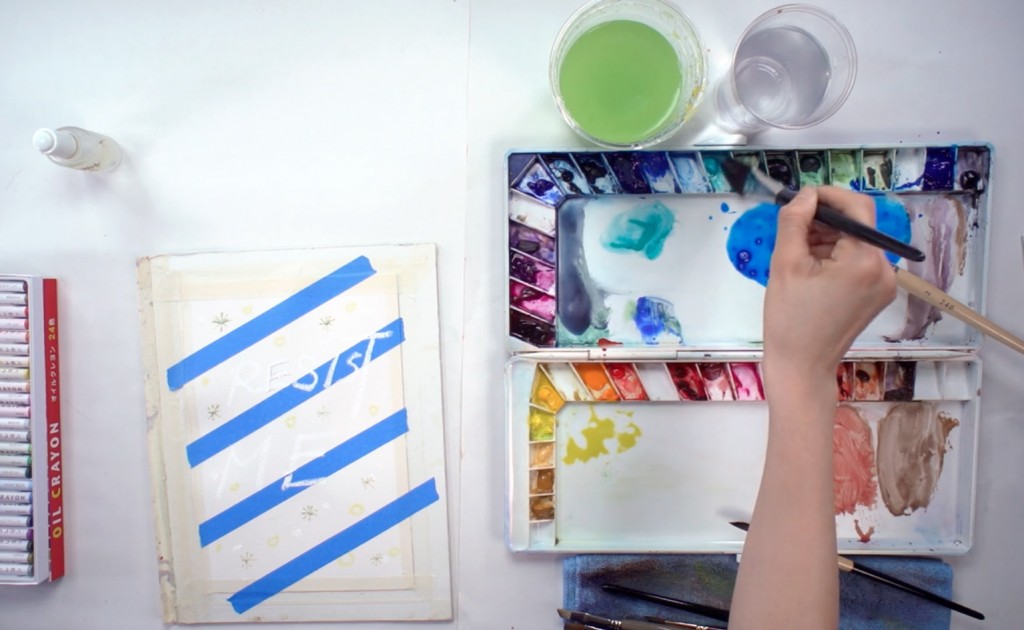 Prep your watercolors while you wait for the masking fluid to dry. Mix a strong Phthalo Turquoise on the palette with the mop brush and not too much water, then switch to the 1" cat's tongue brush and prep some Lemon Yellow paint. Clean the brush, then prep some Cobalt Turquoise Light.
Prep your watercolors while you wait for the masking fluid to dry. Mix a strong Phthalo Turquoise on the palette with the mop brush and not too much water, then switch to the 1" cat's tongue brush and prep some Lemon Yellow paint. Clean the brush, then prep some Cobalt Turquoise Light.
Step 4:
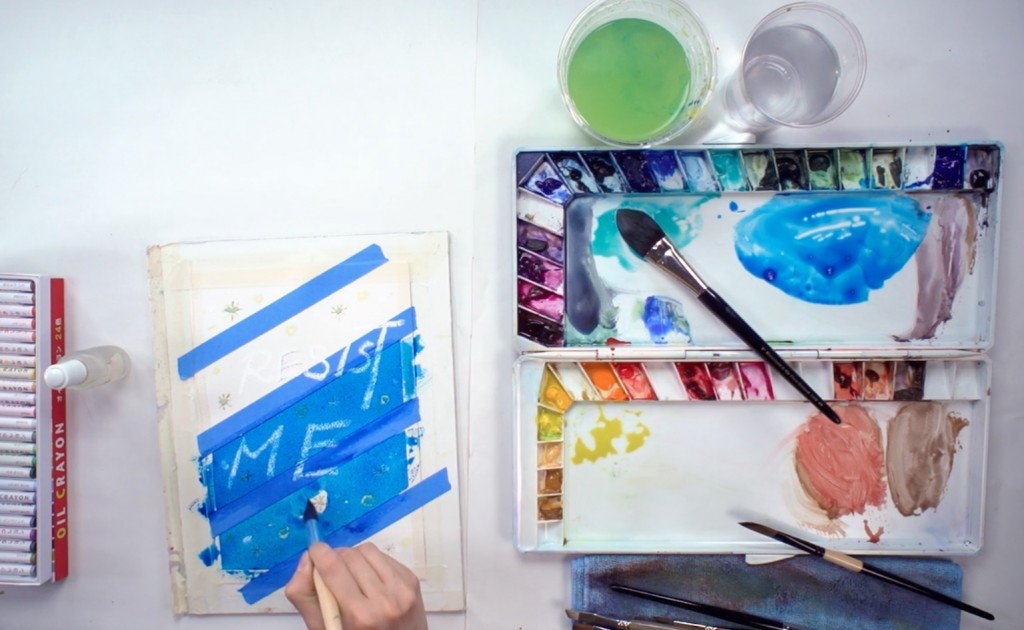 Make sure that the areas with masking fluid are completely dry before you start painting with the mop brush and Phthalo Turquoise. As the oil pastel and crayons are oil-based, they should resist the paint (the tape is a different surface altogether so feel free to paint over it). Add Cobalt Turqoise Light, Lemon Yellow, and Indigo paint with the cat's tongue brush while the paper is still wet, "charging" it with different colors via using this wet-on-wet technique.
Make sure that the areas with masking fluid are completely dry before you start painting with the mop brush and Phthalo Turquoise. As the oil pastel and crayons are oil-based, they should resist the paint (the tape is a different surface altogether so feel free to paint over it). Add Cobalt Turqoise Light, Lemon Yellow, and Indigo paint with the cat's tongue brush while the paper is still wet, "charging" it with different colors via using this wet-on-wet technique.
Step 5:
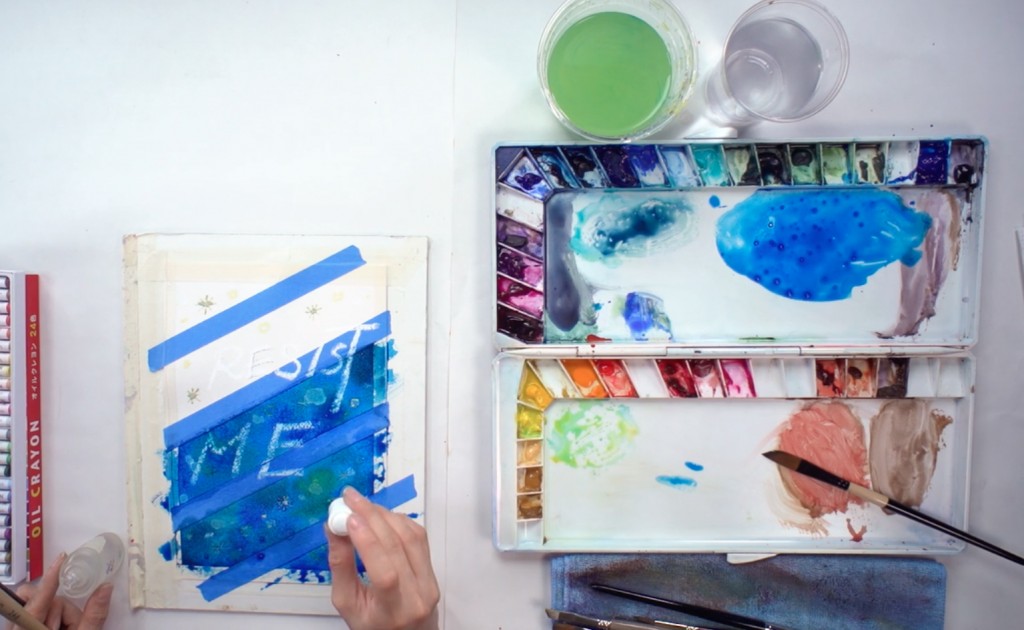 While the paint is wet, you can add drops of alcohol using an eyedropper or spray bottle into the paint. The alcohol pushes pigment away, creating dots of lighter color wherever it's placed. Keep painting with the cat's tongue brush, changing colors whenever you like (make sure to clean the brush before each change so the colors don't mix together completely). When this first layer is done, use a hairdryer or wait for the paper to dry completely before moving to the next step.
While the paint is wet, you can add drops of alcohol using an eyedropper or spray bottle into the paint. The alcohol pushes pigment away, creating dots of lighter color wherever it's placed. Keep painting with the cat's tongue brush, changing colors whenever you like (make sure to clean the brush before each change so the colors don't mix together completely). When this first layer is done, use a hairdryer or wait for the paper to dry completely before moving to the next step.
Step 6:
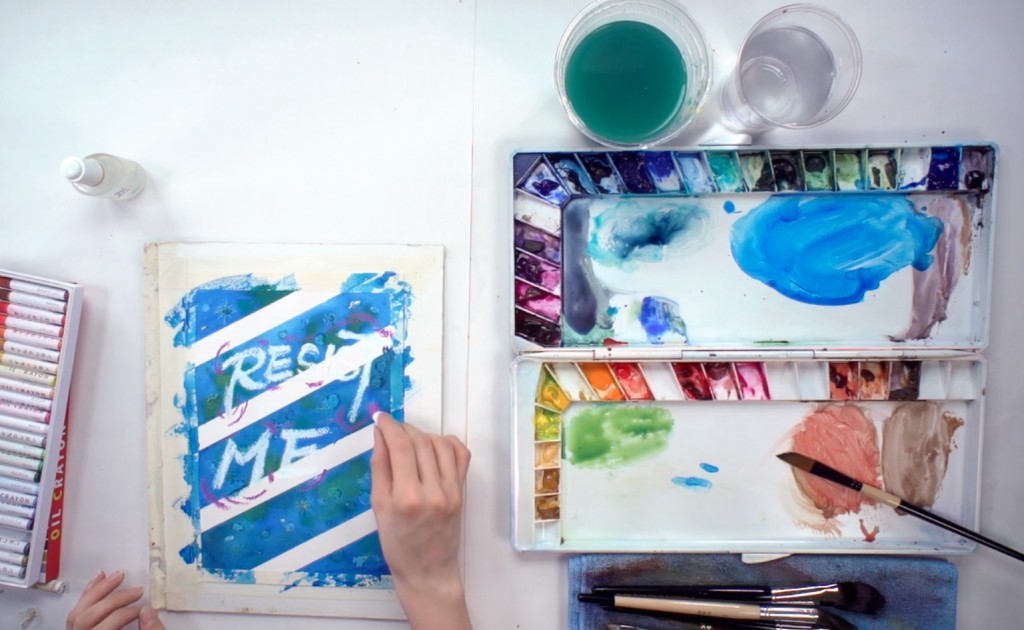 Carefully peel off the diagonal strips of tape. If the paint has bled underneath the tape, you can wet the Escoda angular brush with clean water and lift the paint off the paper. It may or may not come off completely, depending on the color. Go over the words again with the white oil pastel. You can also write in the empty diagonal spaces, and decorate the paper with other crayons.
Carefully peel off the diagonal strips of tape. If the paint has bled underneath the tape, you can wet the Escoda angular brush with clean water and lift the paint off the paper. It may or may not come off completely, depending on the color. Go over the words again with the white oil pastel. You can also write in the empty diagonal spaces, and decorate the paper with other crayons.
Step 7:
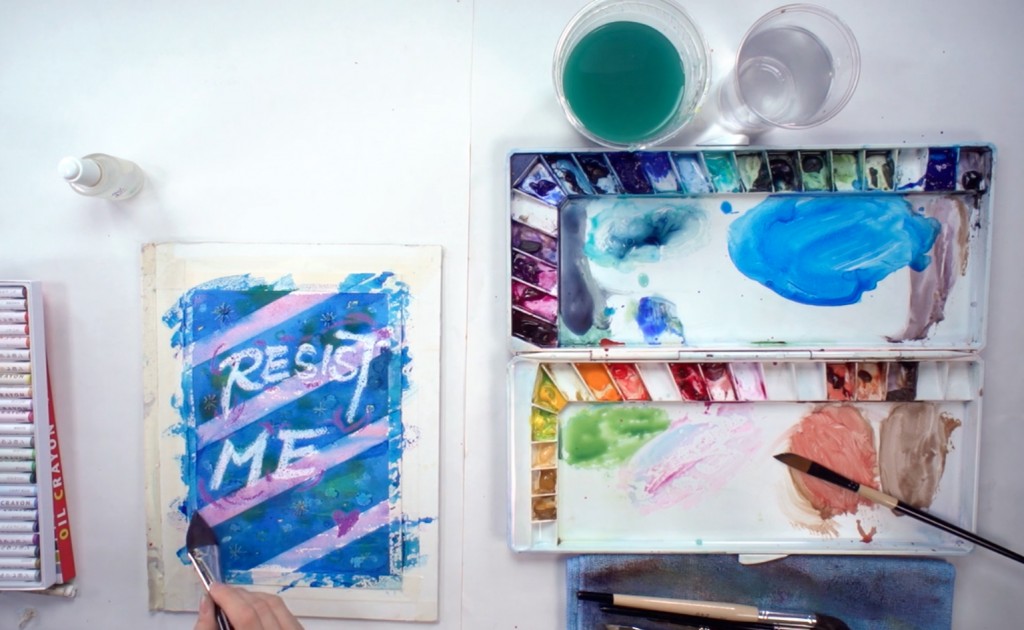 Paint a second layer of paint, this time using a clean cat's tongue brush to mix Rose Doré and a tiny bit of Alizarin Crimson to "glaze" over the painting and fill in any remaining white areas. The blue may bleed a little into the red, which is fine as this creates more harmony in the painting.
Paint a second layer of paint, this time using a clean cat's tongue brush to mix Rose Doré and a tiny bit of Alizarin Crimson to "glaze" over the painting and fill in any remaining white areas. The blue may bleed a little into the red, which is fine as this creates more harmony in the painting.
Step 8:
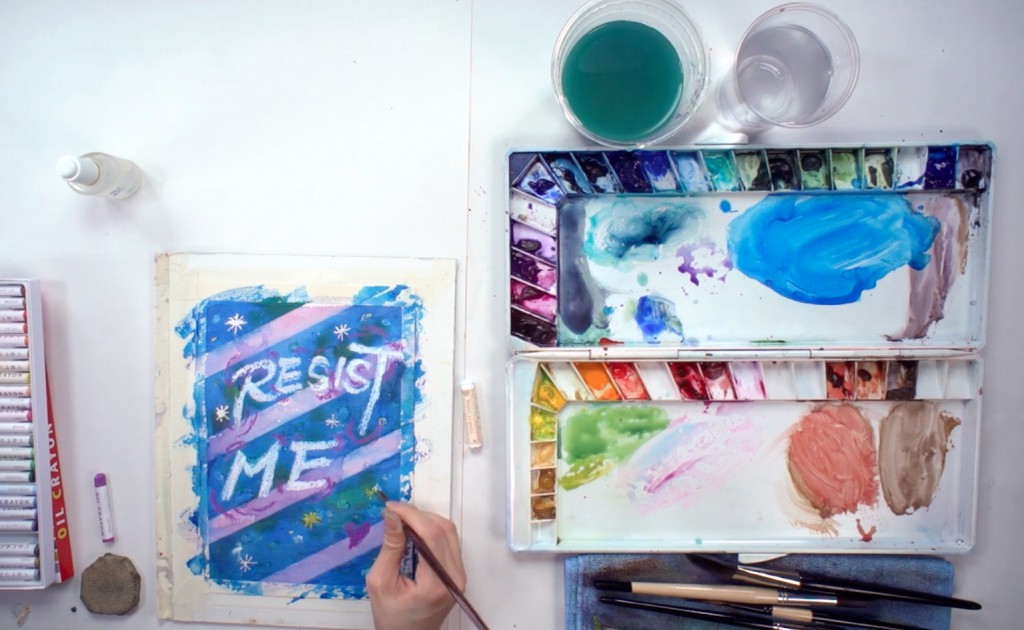 Add some Winsor Violet (Dioxazine Purple) with the mop brush to accent the words or shapes you've drawn with the oil pastel, and wait for this second layer of paint to dry before going over the words again with white oil pastel. Add more oil pastel and crayon accents to finalize your artwork, then use a soft eraser to take off the masking fluid (be careful not to erase any oil pastel or crayon areas). You can leave the masking fluid parts white, or paint them with the Escoda round brush (size 6). When you're satisfied with the whole painting, you can peel off the masking tape around the edge of your paper. Hope you had fun making this project!
Add some Winsor Violet (Dioxazine Purple) with the mop brush to accent the words or shapes you've drawn with the oil pastel, and wait for this second layer of paint to dry before going over the words again with white oil pastel. Add more oil pastel and crayon accents to finalize your artwork, then use a soft eraser to take off the masking fluid (be careful not to erase any oil pastel or crayon areas). You can leave the masking fluid parts white, or paint them with the Escoda round brush (size 6). When you're satisfied with the whole painting, you can peel off the masking tape around the edge of your paper. Hope you had fun making this project!



